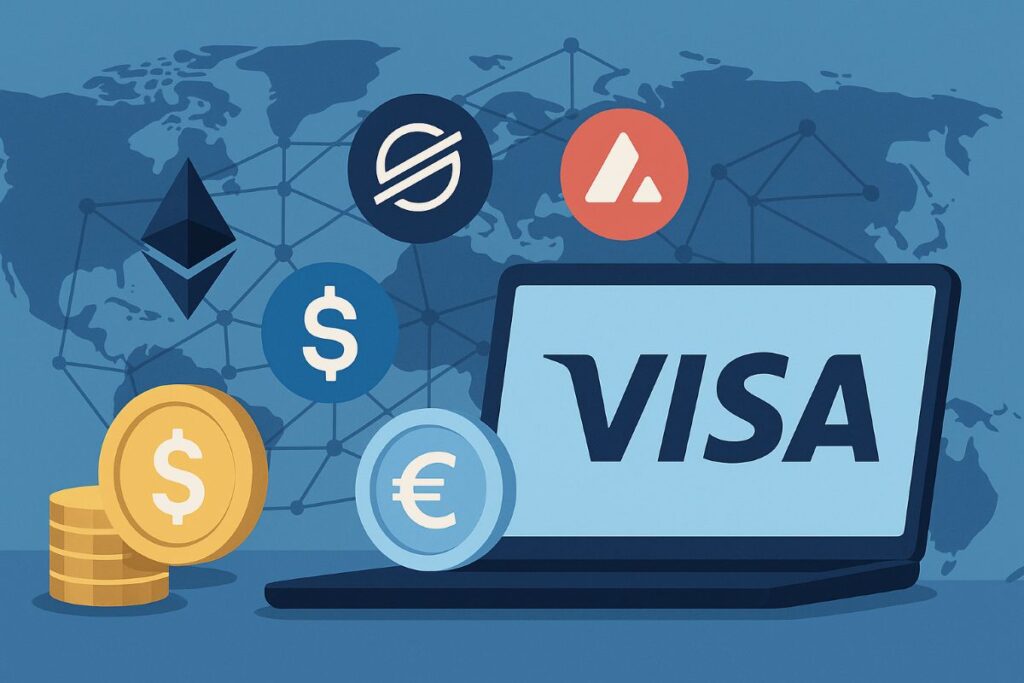In recent years, the landscape of global finance has been significantly transformed by the rise of cryptocurrencies and blockchain technology. Major industry players are increasingly integrating these digital assets into their operations, signifying a shift towards a more decentralized and innovative financial ecosystem. As part of this evolution, Visa, a leader in global payments, is making substantial strides in the crypto domain. This article delves into Visa’s latest expansion in crypto support, its implications for the growing adoption of digital currencies, and the role of emerging technologies like the Best Wallet Token in shaping the future financial landscape.
Visa’s Crypto Expansion: A New Era of Global Payments
Visa Integrates Multi-Stablecoin and Multi-Blockchain Support
Visa has significantly broadened its crypto settlement infrastructure through a strategic partnership with Paxos, adding support for U.S. dollar-backed stablecoins, including PayPal USD ($PYUSD) and Global Dollar ($USDG). Additionally, Circle’s euro-backed $EURC is now part of Visa’s offerings, facilitating seamless transactions across Europe. With the inclusion of blockchains like Stellar and Avalanche, alongside Ethereum and Solana, Visa underscores its commitment to a versatile multi-chain settlement network. Rubail Birwadker, Visa’s Global Head of Growth Products, emphasized the importance of establishing a multi-coin and multi-chain foundation to cater to global partners’ needs, highlighting the transformative potential of trusted and scalable stablecoins.
Implications of Visa’s Crypto Advancements
Visa’s venture into stablecoin settlements commenced in 2020 with $USDC pilot projects. Now, its platform supports four stablecoins across various blockchain networks, backed by actual deployments from banks, fintech companies, and card issuers. This expansion follows the recent enactment of the GENIUS Act in the U.S., which provides a regulatory framework for payment stablecoins, ensuring full-reserve backing and compliance with Know Your Customer (KYC) and Anti-Money Laundering (AML) standards.
The growing acceptance of cryptocurrency is mirrored in the increasing demand for intuitive web3 wallets, such as the Best Wallet, designed to simplify the onboarding process for users. The Best Wallet, already active and raising funds for further Web3 integration, offers a secure and user-friendly cryptocurrency management solution.
The Role of Best Wallet Token ($BEST) in Digital Finance
The Best Wallet app, alongside its native token ($BEST), equips users with essential tools for buying, storing, and exchanging cryptocurrencies, complemented by unique features that enhance user experience. Benefits of the $BEST token within this ecosystem include reduced fees, community governance, and staking rewards. Furthermore, the Best Wallet’s exclusive ‘Upcoming Tokens’ feature grants users early access to promising crypto presales.
Security is paramount in the Best Wallet, employing MPC protection to counteract secret key vulnerabilities prevalent in other wallets. The impending introduction of a debit card feature intends to facilitate retail payments, aligning digital currency use with familiar fiat experiences. This initiative aims to establish a comprehensive Web3 ecosystem, evidencing potential as a leading crypto wallet solution. Those interested in exploring the Best Wallet ecosystem can find more details on acquiring $BEST tokens through the presale, where the project has already amassed over $14 million.
Visa’s Strategic Move into Crypto: Significance and Impact
Visa’s enhanced crypto capabilities provide developers and digital wallets with a wider range of stablecoin and blockchain options, minimizing vendor reliance and streamlining cross-border settlements. As stablecoins integrate into mainstream financial systems, Visa’s updated infrastructure affords flexibility in currency (USD, EUR), token selection ($USDC, $PYUSD, $USDG, $EURC), and blockchain technologies (Ethereum, Solana, Stellar, Avalanche). The financial sector is increasingly embracing cryptocurrencies, with innovative solutions like the Best Wallet Token prepared to address evolving retail preferences.
As with any investment decision, due diligence is crucial. The insights provided in this article are intended to inform and support decision-making processes, not as financial advice.
Editorial Excellence at Our Core
Our editorial process centers on delivering meticulously researched, precise, and balanced content. We adhere to rigorous sourcing standards, ensuring every piece undergoes thorough scrutiny by our expert team to maintain content integrity and value for our audience.
How does Visa’s crypto expansion impact the financial industry?
Visa’s expansion into the crypto realm facilitates easier and faster cross-border transactions by integrating stablecoins and multiple blockchains into its settlement infrastructure. This move reduces transaction times and costs while providing greater flexibility in currency and blockchain options.
What are the key features of the Best Wallet Token ($BEST)?
The Best Wallet Token offers several features, including lower transaction fees, staking rewards, and community governance within its ecosystem. It also provides an innovative ‘Upcoming Tokens’ section, which gives users early access to potential crypto investments and presales.
Are stablecoins a reliable investment option?
Stablecoins provide a unique investment opportunity due to their price stability and backing by fiat currencies. However, the reliability of stablecoins also hinges on the issuer’s regulatory compliance and reserve management. Investors should consider these factors, along with market conditions, before investing.
Will Visa continue to expand its crypto offerings?
Given the increasing adoption of cryptocurrency and blockchain technology, it is plausible that Visa will continue to enhance its crypto offerings. The company’s focus on supporting multiple stablecoins and blockchains suggests a commitment to blending traditional financial services with digital innovations, responding to market demands and technological advancements.

